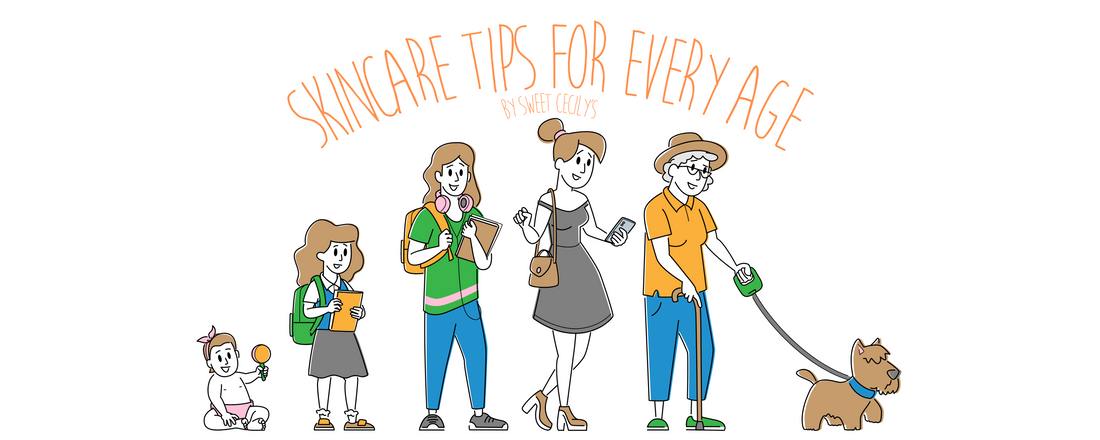
How Does Your Skin Change as You Age?
Share
Throughout this blog we are going to be answering some common questions on what happens to your skin during each stage of life such as puberty, pregnancy, and menopause.
-
What happens to my skin during puberty?
- Your teenage years are where it commonly all starts, at puberty. You may notice changes in your mood such as having a short temper or becoming impatient. You might also notice parts of your body changing, but so is everyone else’s! Although it may seem like you’re the only person going through it, everyone else around your age is too.
The most common (and very normal!) change to your skin is the appearance of acne, whether you get a few spots a year, or a few spots a week, it happens. In all our bodies we have a range of hormones, one of them being ‘testosterone’, which you may know as being the ‘male sex hormone’, however it is both men and women who produce it! The boost in testosterone that we all experience during puberty can trigger acne because it makes our oil glands grow bigger, producing more oiliness, creating acne. This is the reason acne is more common in teenage boys, they have more testosterone. It’s important to know that you shouldn’t touch your spots (although we are all guilty of a satisfying squeeze), but to find a way to deal with it that’s best for you. Washing your face more may help reduce acne or being prescribed a cream may be the only option, but it’s important to recognise that everyone’s skin is different and different routines and products work differently for everyone.
As well as acne, the appearance of stretch marks is also a big part of puberty. A stretch mark is just a fine line/s in your skin which may appear purple or red that can look indented. These marks occur simply when you’re growing in a short period of time. You may find them on your legs, chest area or back, and you might read that there are ways to get rid of them but it’s not necessary, there’s nothing wrong with having them, they are a perfectly normal part of being a human that has skin!
These two changes are just the most common, but we decided to pick these out as they are understandably the ones that a young person becomes the most insecure by, but they aren’t anything to be embarrassed about.
-
How do you tell if your skin is stressed?
- The next stage where you may find that your skin is changing again may be around leaving school or college and getting your first job or going to university. This can be a stressful time and like puberty, can cause hormones to fluctuate. Although stress can occur at any time in your life, this is going to be a big milestone in your life where you may feel overwhelmed by the amount of stress -or not, if you’re lucky!
We have the hormone called Cortisol which is nicknamed the ‘stress hormone’. Whenever we feel worried, scared, or any sense of danger, cortisol is released and basically tells your brain that you either need to fight or run away.
Excess Cortisol in the body can lead to a feeling of anxiety which may make you feel worried or scared about what is going to happen next.
Here are some of the ways you can tell your skin is stressed…
Redness & Irritation
Sometimes when you’re stressed you may find yourself subconsciously touching your face and rubbing your eyes, resulting in redness and irritation.
Skin Conditions
If you already have skin conditions such as Eczema and Psoriasis, it has been said that increased levels of cortisol can worsen your condition. You may find that when you’re stressed you have bad flare ups of these conditions.
Oiliness & Breakouts
Studies show that stress can confuse the balance of bacteria, which provides the perfect breeding ground for acne.
Stress induced acne is most common around the mouth and chin.
Cortisol can push oil production on the face, which can lead to clogged pores and acne.
Dryness & Dullness
Skin heals less quickly when you’re stressed so it won’t renew itself like it should every 27 days.
Cortisol can disrupt your skin's natural barrier, which can cause your skin to lose moisture.
-
How does pregnancy affect your skin?
- During pregnancy, you may notice some changes to your skin, nails, and hair. Although we’ve said the word change, that doesn’t necessarily mean bad.
For example, usually each hair on your head grows for 2-6 years, then rests for a few months before falling out, but when you’re pregnant, your hair rests for longer, creating a thicker head of hair. When you’re pregnant your hormone levels increase, providing more nutrients to your body, not only helping your hair but also helping your nails grow longer and stronger. However, sadly, enjoy it while it lasts as it disappears after pregnancy.
Skin wise, your relationship with your skin may fluctuate – but it is important to note that this is based on individuals, you may not notice any differences in your skin.
Sensitive Skin – Due to increased hormone levels, and because your skin stretches as your baby grows, skin conditions that you have never dealt with before, such as eczema, may appear.
Dark Skin Patches – Melasma is a skin condition where brown patches appear on your face. This is when hormone levels are increased and are at their height during the third trimester.
Swelling – Usually, swelling only occurs in ankles and legs, but your fingers can get a little bit bigger. This occurs for a few reasons; as your baby grows your uterus presses on a vein that goes to your leg, your hormones make your walls of your veins softer, and you produce more blood than usual to help your baby grow.
Acne – All of the hormones that fluctuate during pregnancy can cause oil glands to create more oil, causing breakouts.
And ending on a high…
The Pregnancy Glow – Due to the combination of hormones, oil and an increase of blood, your skin can seem positively luminous during pregnancy.
Always seek professional advice if you feel there are any serious, abnormal changes to your skin.
-
How does perimenopause affect your skin
- Premature menopause begins around 8-10 years before menopause, usually starting in your mid-40s. The average length of this stage differs between the individual, on average pre-menopause lasts around 4 years, but for some it can be for as little as a few months and for others it can last longer than 4 years. Women make estrogen their whole lives, and once you enter pre-menopause your estrogen levels start to decrease which throws off the other hormone, progesterone – these hormones and responsible for ovulation and menstruation.
During perimenopause, a symptom that you may find is common between women is hot flushes. When you have hot flushes, your skin begins to turn red and can become irritated. You might also have breakouts and skin that was previously balanced might start to get dry or oily patches.
There isn’t any treatment to stop pre-menopause as it is a natural part of life. You know pre-menopause has stopped once your period stops. 12 months after your last period, you then enter menopause..
-
How does menopause affect the skin?
- The menopausal transition often begins between the ages of 45 and 55, usually lasting around 7 years, but can be as long as 14. The duration of your menopause depends on a range of lifestyle factors such as eating habits and smoking, and race or ethnicity even being a factor.
During menopause you may notice a few different changes to your skin such as:
Dry Skin – in menopause skin loses some ability to hold water so skin can get quite dry, you may find this more noticeable when the air is dry, for example, in an air-conditioned room.
Acne – like in perimenopause, because your female hormones have dropped, it is possible that you develop teenage-like acne.
Irritated skin – as you get older the pH levels of our skin changes, and with this change becomes sensitivity, so you may find that your skin is developing rashes and becoming irritated easier than it ever has.
These are skin changes that can be helped, applying the right moisturisers and creams for your skin can help clear up acne and dry skin. If you do find yourself experimenting with new products, make sure to do a patch test on your skin to avoid any more irritation.
Your GP can offer treatments and suggest lifestyle changes if you have severe menopausal symptoms that interfere with your day-to-day life.
-
What does ageing skin look like?
- Mature skin can appear thinner and not look quite as plump and smooth as it once did. Your veins and bones appear more visible, and the wounds that would heal within days now take weeks. If you have been an avid sun worshipper throughout your life, this may affect the condition of your skin. Here is what you can do to give your skin a helping hand to stay as healthy as possible:
Limit time in the sun
Use sunscreen
Wear protective clothing
Avoid tanning
UV rays can be damaging to skin, especially when you’re older as your skin thins due to the loss of elastic tissue – which is why loose/’hanging’ skin occurs. The rays can cause wrinkles, dryness, age spots and even cancer, so when you are out in the sun you need to be careful of how long you are out in it for.
You may suffer from dry skin, which may be caused by health problems, such as diabetes or kidney diseases. Some medicines also may make skin itchy, and because older people have thinner skin, scratching may cause bleeding which, as mentioned before, wounds take longer to heal. Along with dry skin, you may find that you bruise more easily, simply because your blood vessels become more fragile, allowing a bruise to be clearer than it would be all those years ago.
Your skin may change with age but it’s important to keep looking after it with lotions and other moisturisers.
